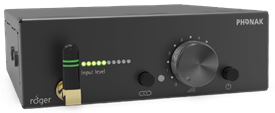Hearing Assistance Systems

Induction Loop T Position logo
For a long time, the only method of transmitting audio into a user’s hearing aid was using an induction loop. This entailed an audio source being fed into an induction loop driver. That driver induced a current in a loop of thin cable or copper tape around the space creating magnetic fluctuations, which was picked up by the telecoil in a user’s hearing aid and converted to sound. The telecoil bypasses the users hearing aid microphone, giving a clearer sound when done properly.

Various pieces of Infra Red equipment
Whilst induction loops are relatively simple systems, they can easily be installed in small spaces like reception areas. They become more difficult in large spaces and spaces in close proximity to other areas with induction loops. There are ways to mitigate these issues such as using phased array loops, two loops working together to reduce the sound spill into other areas. Or using Infra-Red which can transmit over wide areas but won’t travel through walls. But the phased array systems are expensive and require the floor to be completely clear to be laid. The Infra-Red systems require users to have an Infra-Red receiver which is placed around their neck and acts as a mini induction loop. Thus, users need to get a receiver from the building reception and have it visible around their neck.

Auracast Logo

Ampetronic Auricast transmitter
As we move into the digital world, things become a little easier to create better systems. But they require the hearing aid manufacturers to integrate technology into the hearing aid. A lot of hearing aids have started to have basic Bluetooth receivers embedded in them. This allows a user to connect their hearing aid to their television, computer or smart device. Currently, this is one transmitter to one receiver, so doesn’t work when you need to transmit to a whole space. Bluetooth now has a broadcast version called Auracast (https://www.bluetooth.com/auracast/). This system will allow multiple connections to one transmitter. It is hoped that hearing aid manufacturers will add it to hearing aids in the future. In the shorter term, Auracast headphones have started to appear on the market. And smart devices will also soon be able to pick up the Auracast stream and if you have your hearing aid connected to your smart device, it will allow you to pick up the Auracast stream. Whilst all this is positive, there is a latency issue, with the potential of tens of milliseconds being added to the stream, depending on how many device hops it take to get the audio to the hearing aid. In a typical space, you will have a microphone, audio processor and some form of transmitter. All adding a delay to the stream compared to straight from the presenters mouth. Add in a smart device, and the delay between lip reading and hearing becomes too much.
A similar system to Auracast has been out for a while. This time it uses the Wi-Fi network to transmit the audio stream. Similar to Auracast it has latency issues. Often more than Auracast as if you are using the building Wi-Fi, the latency will vary greatly depending on how many users are using Wi-Fi across the whole building. However, the Wi-Fi system can often provide more streams, so multi-language translation could be all transmitted on the same system as the hearing assistance. The Sennheiser MobileConnect (https://www.sennheiser.com/en-gb/catalog/products/bi-directional-communication/mobileconnect/mobileconnect-station-508895) system can allow a user to verbally ask a question using their smarts devices microphone. This question would not only be transmitted on the Wi-Fi stream for the hearing aid users to hear, but could also be connected to the room public address system for all the room to hear. Both Auracast and Wi-Fi systems currently require a user to manually connect to the stream. Often via scanning a QR code.

Phonak Roger Wallpilot
One of the world leading hearing aid manufacturers, Phonak, have a system that is simple for a Phonak hearing aid user to connect to without need to identify themselves by screening a QR code. Their Roger (https://www.phonak.com/en-uk/hearing-devices/microphones/roger-for-education) system uses a device, Wallpilot, to automatically change the Phonak hearing aid to that rooms network.

Phonak Roger Basestation
Various options for audio transmission, depending on the room size and type, are available. In teaching spaces the Roger Base station would take a feed from the audio processor. This simple addition makes retro fitting the Roger system into all the University of Edinburgh teaching spaces fairly easy. As presenters already use wireless microphones in these spaces, no additional training would be required.Presenters with hearing aids could also have their own portable Roger Touchscreen Microphone that would allow them to hear any questions being asked by the students. This would only really work in smaller rooms and we are currently testing these out to see how effective they are. Roger Touchscreen Microphones could also be used in a Teaching Studio environment. Although more testing and procedures to allow these to work with the room system will need done.
The Roger system also has a Multimedia Hub that connects to PC’s and smart devices via USB. This allows that devices audio to be transmitted onto the rooms network. This is ideal for Microsoft Teams Rooms. The Multimedia Hub would connect to the MTR and a transmit to the Roger Touchscreen Microphone. This in turn would mix the in room meeting participants and the online audio. Again, simple and easy to retro fit into existing meeting spaces.
Learning Spaces Technology will continue to look and test all hearing assistance systems to ensure we have the best fit for all our users. We are also happy to discuss users requirements in our Learning and Teaching Spaces. Please contact us at learningspacestechnology@ed.ac.uk.




Comments are closed
Comments to this thread have been closed by the post author or by an administrator.